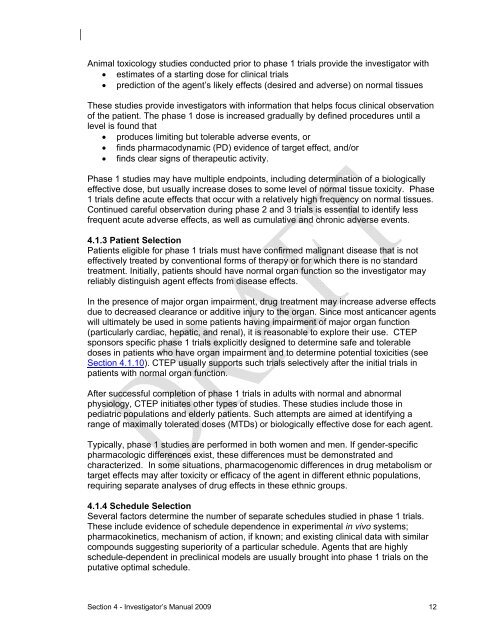A Manual for Participants in Clinical Trials of Investigational Agents ...
A Manual for Participants in Clinical Trials of Investigational Agents ...
A Manual for Participants in Clinical Trials of Investigational Agents ...
Create successful ePaper yourself
Turn your PDF publications into a flip-book with our unique Google optimized e-Paper software.
Animal toxicology studies conducted prior to phase 1 trials provide the <strong>in</strong>vestigator with<br />
• estimates <strong>of</strong> a start<strong>in</strong>g dose <strong>for</strong> cl<strong>in</strong>ical trials<br />
• prediction <strong>of</strong> the agent’s likely effects (desired and adverse) on normal tissues<br />
These studies provide <strong>in</strong>vestigators with <strong>in</strong><strong>for</strong>mation that helps focus cl<strong>in</strong>ical observation<br />
<strong>of</strong> the patient. The phase 1 dose is <strong>in</strong>creased gradually by def<strong>in</strong>ed procedures until a<br />
level is found that<br />
• produces limit<strong>in</strong>g but tolerable adverse events, or<br />
• f<strong>in</strong>ds pharmacodynamic (PD) evidence <strong>of</strong> target effect, and/or<br />
• f<strong>in</strong>ds clear signs <strong>of</strong> therapeutic activity.<br />
Phase 1 studies may have multiple endpo<strong>in</strong>ts, <strong>in</strong>clud<strong>in</strong>g determ<strong>in</strong>ation <strong>of</strong> a biologically<br />
effective dose, but usually <strong>in</strong>crease doses to some level <strong>of</strong> normal tissue toxicity. Phase<br />
1 trials def<strong>in</strong>e acute effects that occur with a relatively high frequency on normal tissues.<br />
Cont<strong>in</strong>ued careful observation dur<strong>in</strong>g phase 2 and 3 trials is essential to identify less<br />
frequent acute adverse effects, as well as cumulative and chronic adverse events.<br />
4.1.3 Patient Selection<br />
Patients eligible <strong>for</strong> phase 1 trials must have confirmed malignant disease that is not<br />
effectively treated by conventional <strong>for</strong>ms <strong>of</strong> therapy or <strong>for</strong> which there is no standard<br />
treatment. Initially, patients should have normal organ function so the <strong>in</strong>vestigator may<br />
reliably dist<strong>in</strong>guish agent effects from disease effects.<br />
In the presence <strong>of</strong> major organ impairment, drug treatment may <strong>in</strong>crease adverse effects<br />
due to decreased clearance or additive <strong>in</strong>jury to the organ. S<strong>in</strong>ce most anticancer agents<br />
will ultimately be used <strong>in</strong> some patients hav<strong>in</strong>g impairment <strong>of</strong> major organ function<br />
(particularly cardiac, hepatic, and renal), it is reasonable to explore their use. CTEP<br />
sponsors specific phase 1 trials explicitly designed to determ<strong>in</strong>e safe and tolerable<br />
doses <strong>in</strong> patients who have organ impairment and to determ<strong>in</strong>e potential toxicities (see<br />
Section 4.1.10). CTEP usually supports such trials selectively after the <strong>in</strong>itial trials <strong>in</strong><br />
patients with normal organ function.<br />
After successful completion <strong>of</strong> phase 1 trials <strong>in</strong> adults with normal and abnormal<br />
physiology, CTEP <strong>in</strong>itiates other types <strong>of</strong> studies. These studies <strong>in</strong>clude those <strong>in</strong><br />
pediatric populations and elderly patients. Such attempts are aimed at identify<strong>in</strong>g a<br />
range <strong>of</strong> maximally tolerated doses (MTDs) or biologically effective dose <strong>for</strong> each agent.<br />
Typically, phase 1 studies are per<strong>for</strong>med <strong>in</strong> both women and men. If gender-specific<br />
pharmacologic differences exist, these differences must be demonstrated and<br />
characterized. In some situations, pharmacogenomic differences <strong>in</strong> drug metabolism or<br />
target effects may alter toxicity or efficacy <strong>of</strong> the agent <strong>in</strong> different ethnic populations,<br />
requir<strong>in</strong>g separate analyses <strong>of</strong> drug effects <strong>in</strong> these ethnic groups.<br />
4.1.4 Schedule Selection<br />
Several factors determ<strong>in</strong>e the number <strong>of</strong> separate schedules studied <strong>in</strong> phase 1 trials.<br />
These <strong>in</strong>clude evidence <strong>of</strong> schedule dependence <strong>in</strong> experimental <strong>in</strong> vivo systems;<br />
pharmacok<strong>in</strong>etics, mechanism <strong>of</strong> action, if known; and exist<strong>in</strong>g cl<strong>in</strong>ical data with similar<br />
compounds suggest<strong>in</strong>g superiority <strong>of</strong> a particular schedule. <strong>Agents</strong> that are highly<br />
schedule-dependent <strong>in</strong> precl<strong>in</strong>ical models are usually brought <strong>in</strong>to phase 1 trials on the<br />
putative optimal schedule.<br />
Section 4 - Investigator’s <strong>Manual</strong> 2009 12




